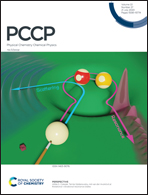Effect of spin–phonon interactions on Urbach tails in flexible [M2(bdc)2(dabco)]†
Abstract
The optical properties of metal–organic frameworks [M2(bdc)2(dabco)] (M = Co, Ni, Cu, Zn) in the wavelength region of 300–1000 nm were studied, and the electronic band-to-band transitions were determined and characterized by the Kubelka–Munk approach and DFT calculations. Urbach edges for band-to-band transitions were determined. The effect of spin–phonon interactions on the width of Urbach edges in paramagnetic [M2(bdc)2(dabco)] is discussed. The obtained data may be useful to interpret polymerization, hybridization, and catalytic reactions in [M2(bdc)2(dabco)] pores and to design electronic and optical devices.
![Graphical abstract: Effect of spin–phonon interactions on Urbach tails in flexible [M2(bdc)2(dabco)]](/en/Image/Get?imageInfo.ImageType=GA&imageInfo.ImageIdentifier.ManuscriptID=D0CP01944E&imageInfo.ImageIdentifier.Year=2020)


 Please wait while we load your content...
Please wait while we load your content...